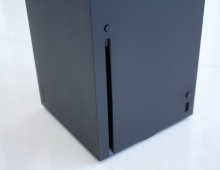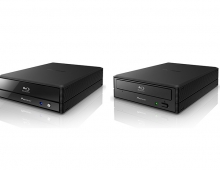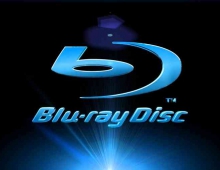Interview With Mr Brian Zucker of Dell Concerning Blu-Ray
1. Page 1
 Brian Zucker serves as Technology Evangelist in the Office of the CTO for
Dell. In this role, Brian is responsible for driving a deeper understanding
of new PC technologies while also helping to define future product direction.
He is responsible for communicating the customer benefits of new technologies
in emerging products both within the company and to the outside world.
Brian Zucker serves as Technology Evangelist in the Office of the CTO for
Dell. In this role, Brian is responsible for driving a deeper understanding
of new PC technologies while also helping to define future product direction.
He is responsible for communicating the customer benefits of new technologies
in emerging products both within the company and to the outside world.
Brian joined Dell over fifteen years ago while completing his postgraduate studies. During his tenure at Dell he has held many different engineering and managerial roles. Ten years ago Brian took the lead engineering position for desktop OEM engineering where he helped launch the Dimension product line. Since that time Brian has led many efforts for architecting Dimension desktop systems and related client products.
Brian holds an MSEE from the University of Texas at Austin, with specialization in computer engineering. He has a BS in computer engineering from Tulane University in New Orleans.
On behalf of the Blu-Ray Disc Acossiation, Mr Zucker was willing to answer
to CDRinfo's questions regarding the latest Blu-Ray technology developments.
It is obvious that an efficient video encoding/compression scheme, (such as AVC, H.264) would allow consumers to store and enjoy many hours of High Definition (HD) content on current dual layer DVD media. So, why the need for a new DVD format?
The space needed to store high definition content overcomes the compression
rates that are gained by going to the newer codecs. With data rates of around
12-15Mb/s for a high definition H.264 AVC stream we are talking about a 50%-100%
increase over what we see on DVD today with standard definition material and
MPEG2. So there is a definite need to increase the capacity as well. You would
not be able to get many hours of HD content on a DVD at a reasonable compression
rate.
Could you explain the main advantages of the Blu-ray format compared to the rival HD DVD format?
Blu-ray Disc offers unparalleled capacities and has
the
broadest industry support from movie studios, music companies, consumer electronics
companies, and of course a large portion of the IT industry. Blu-ray Disc
is focused on cross platform enablement with the requirements of gaming, movie
and music playback, and data backup all comprehended in the design. Blu-ray
disc
is designed from the ground up for a 10-15 year life span and is not simply
an effort to extend the life of a previous generation.
Blu-Ray-ready products will cost significantly more than current DVD A/V home equipment. How will the Blu-Ray companies convince the consumers to invest on new home entertainment devices?
As with all new technologies the issue of cost
relates to market demand and volume manufacturing. Blu-ray Disc should have
a similar pricing model to what DVD had when it launched where a consumer
would initially see higher prices until wide spread adoption took hold. Once
volumes
ramp, pricing will certainly come down.
Could you give us an update on the progress relating to the Blu-Ray specifications approved by the BDA?
On January 5, 2006 the Blu-ray Disc Association announced
that all three Blu-ray books (BD-ROM, BD-R, and BD-RE) are available for
licensing. This is unprecedented given that the format launches with write
capability
from the start.
Sony believes that the PS3 game console will boost the Blu-Ray success. Gates has also promised an HD DVD–ROM as an external peripheral for the Xbox 360. Do you believe that Sony has a point here? Will games consoles help users accept both formats more readily and what will be the pricing policy in this instance to avoid driving the price of games consoles through the roof?
Getting
Blu-ray Disc players in the hands of the consumers will be key to driving the
adoption of the format. The Playstation 3 is just one of many new products
coming out this year that will help accelerate the acceptance of Blu-ray Disc
in the
marketplace. We appreciate Sony’s help with both the development of the
format and for helping to stimulate customer interest in high definition content.
Consumers are concerned about whether they will be able to enjoy HD content on their PCs. Considering that currently, the majority of PC equipment is not equipped with an HDMI (digital) port, are there any plans to provide digital content for current, unprotected DVI or analog monitor ports?
The specification
allows for full display of high definition content through unprotected DVD
or analog outputs but ultimately the display resolutions will be dictated
by the
studios and their specific requirements for legacy ports.
Lately we have experienced a large debate regarding the content protection schemes featured by both HD DVD and Blu-Ray formats. Microsoft and Intel have decided to support the HD DVD format. How does the Blu-Ray protection scheme differ from that proposed for the HD DVD format?
Both formats will be using
the AACS specification for content protection. Blu-ray Disc differs in that
additional
elements (BD+ and RomMark) have been added to help develop a robust specification
to meet the needs of consumers, manufacturers, and content providers. BD+
relates to the ability to keep content from playing on a known hacked player
while
the RomMark is a manufacturing mark placed on the disc to help reduce mass
piracy
of discs.
Could you explain in plain words what Mandatory Managed Copy protection means to the end user and why the BDA decided not to implement it its format?
Actually, Mandatory Managed Copy will be implemented on Blu-ray Disc. MMC is a part of the AACS specification and as such the Blu-ray Disc format will follow the implementation guidelines set by this underlying specification. Mandatory Managed Copy is the ability to transfer or make copies of the digital commercial content on a protected disc under policies and fees dictated by the content providers. For instance, a consumer could buy a Blu-ray Disc and then make a back up copy for future use in case of damage, transfer the movie to a portable player for viewing, etc.





















